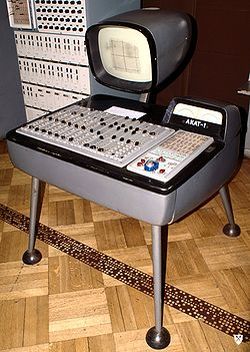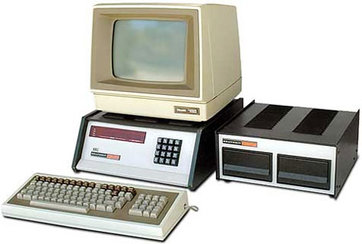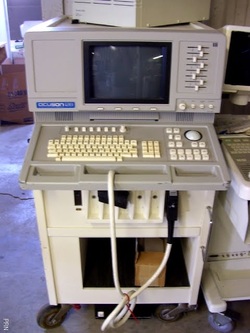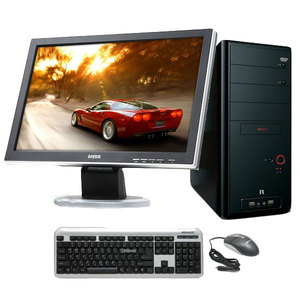Types of Computers
Computers come in a variety of types designed for different purposes, with different capabilities and costs.
Microcomputers
A microcomputer is a computer that has a microprocessor chip as its CPU. They are often called personal computers because they are designed to be used by one person at a time. Personal computers are typically used at home, at school, or at a business. Popular uses for microcomputers include word processing, surfing the web, sending and receiving e-mail, spreadsheet calculations, database management, editing photographs, creating graphics, and playing music or games.
Personal computers come in two major varieties, desktop computers and laptop computers:
Desktop computers are larger and not meant to be portable. They usually sit in one place on a desk or table and are plugged into a wall outlet for power. The case of the computer holds the motherboard, drives, power supply, and expansion cards. This case may lay flat on the desk, or it may be a tower that stands vertically (on the desk or under it). The computer usually has a separate monitor (either a CRT or LCD) although some designs have a display built into the case. A separate keyboard and mouse allow the user to input data and commands.
Laptop or notebook computers are small and lightweight enough to be carried around with the user. They run on battery power, but can also be plugged into a wall outlet. They typically have a built-in LCD display that folds down to protect the display when the computer is carried around. They also feature a built-in keyboard and some kind of built-in pointing device (such as a touch pad).
While some laptops are less powerful than typical desktop machines, this is not true in all cases. Laptops, however, cost more than desktop units of equivalent processing power because the smaller components needed to build laptops are more expensive.
Computer types
Since the invention of computers from first generation and fourth generation computers, they have been classified according to their types and how they Operate that is input, process and output information. Below you will get a brief discussion on various types of Computers we have Computer types can be divided into 3 categories according to electronic nature. Types of computers are classified according to how a particular Computer functions. These computer types are
Computers come in a variety of types designed for different purposes, with different capabilities and costs.
Microcomputers
A microcomputer is a computer that has a microprocessor chip as its CPU. They are often called personal computers because they are designed to be used by one person at a time. Personal computers are typically used at home, at school, or at a business. Popular uses for microcomputers include word processing, surfing the web, sending and receiving e-mail, spreadsheet calculations, database management, editing photographs, creating graphics, and playing music or games.
Personal computers come in two major varieties, desktop computers and laptop computers:
Desktop computers are larger and not meant to be portable. They usually sit in one place on a desk or table and are plugged into a wall outlet for power. The case of the computer holds the motherboard, drives, power supply, and expansion cards. This case may lay flat on the desk, or it may be a tower that stands vertically (on the desk or under it). The computer usually has a separate monitor (either a CRT or LCD) although some designs have a display built into the case. A separate keyboard and mouse allow the user to input data and commands.
Laptop or notebook computers are small and lightweight enough to be carried around with the user. They run on battery power, but can also be plugged into a wall outlet. They typically have a built-in LCD display that folds down to protect the display when the computer is carried around. They also feature a built-in keyboard and some kind of built-in pointing device (such as a touch pad).
While some laptops are less powerful than typical desktop machines, this is not true in all cases. Laptops, however, cost more than desktop units of equivalent processing power because the smaller components needed to build laptops are more expensive.
Computer types
Since the invention of computers from first generation and fourth generation computers, they have been classified according to their types and how they Operate that is input, process and output information. Below you will get a brief discussion on various types of Computers we have Computer types can be divided into 3 categories according to electronic nature. Types of computers are classified according to how a particular Computer functions. These computer types are
- Analogue Computer
- Digital Computer
- Hybrid Computer

Analogue Computer
Analogue types of Computer uses what is known as analogue signals that are represented by a continuous set of varying voltages and are used in scientific research centers?, hospitals and flight centers.With analogue types of computer no values are represented by physical measurable quantities e.g. voltages. Analogue computer types program arithmetic and logical operations by measuring physical changes i.e. temperatures or pressure.

Digital Computer
Digital Type Computer
With these types of computers operation are on electrical input that can attain two inputs, states of ON=1 and state of OFF = 0. With digital type of computers data is represented by digital of 0 and 1 or off state and on state. Digital computer type recognizes data by counting discrete signal of (0 0r 1), they are high speed programmable; they compute values and stores results. After looking at the Digital computer type and how it functions will move to the third computer type as mentioned above.
With these types of computers operation are on electrical input that can attain two inputs, states of ON=1 and state of OFF = 0. With digital type of computers data is represented by digital of 0 and 1 or off state and on state. Digital computer type recognizes data by counting discrete signal of (0 0r 1), they are high speed programmable; they compute values and stores results. After looking at the Digital computer type and how it functions will move to the third computer type as mentioned above.

Hybrid Computer
Hybrid Type Computer
Hybrid computer types are very unique, in the sense that they combined both analogue and digital features and operations. With Hybrid computers operate by using digital to analogue convertor and analogue to digital convertor. By linking the two types of computer above you come up with this new computer type called Hybrid.I hope this article on computer types gives you a basic foundation of how computers are classified and how they operate. Next article will focuses on computer sizes definition and characteristics, for more on Computer resources and related articles check out Computer Resource and if you found information relevant please help share these to as many people as possible whom you think would benefit from them.
The Types of computers range from the Hybrid to the Analog types. The computers you come across in the daily course of your day range from laptops, palmtops and towers, to desktop computers, to name a few. But the very word “computers” reminds one of the desktop computers used in offices or homes. Different categories of computes have been devised in keeping with our varied needs.
The Types Of Computers: Analog and Hybrid (classification based on operational principle)
2. The Microcomputer – These are the most frequently used computers better known by the name of “Personal computers”. This is the type of computer meant for public use. Other than Desktop Computer the choice ranges as follows:
Yet another category of computer is the Super Computers. It is somewhat similar to mainframe computers and is used in economic forecasts and engineering designs. Today life without computers is inconceivable. Usage of different types of computers has made life both smooth and fast paced.
Advantages and Disadvantages of Analog Computers
The advantage of an analog computer is that it can simultaneously find solutions to several mathematical problems and that too while being precise unlike the digital computer. But it is not free of drawbacks. Unlike the digital computer it lacks speed of calculation. There are other functional problems which mar the efficiency of analog systems. Of these, the problems of non-linearties, temperature co-efficient, parasitic effects and noise floor are the main problems so to say.
Hybrid computer types are very unique, in the sense that they combined both analogue and digital features and operations. With Hybrid computers operate by using digital to analogue convertor and analogue to digital convertor. By linking the two types of computer above you come up with this new computer type called Hybrid.I hope this article on computer types gives you a basic foundation of how computers are classified and how they operate. Next article will focuses on computer sizes definition and characteristics, for more on Computer resources and related articles check out Computer Resource and if you found information relevant please help share these to as many people as possible whom you think would benefit from them.
The Types of computers range from the Hybrid to the Analog types. The computers you come across in the daily course of your day range from laptops, palmtops and towers, to desktop computers, to name a few. But the very word “computers” reminds one of the desktop computers used in offices or homes. Different categories of computes have been devised in keeping with our varied needs.
The Types Of Computers: Analog and Hybrid (classification based on operational principle)
- Analog Computers: The analog computer is almost an extinct type of computer these days. It is different from a digital computer in respect that it can perform numerous mathematical operations simultaneously. It is also unique in terms of operation as it utilizes continuous variables for the purpose of mathematical computation. It utilizes mechanical, hydraulic, or electrical energy or operation.
- Hybrid computers: These types of computers are, as the name suggests, a combination of both Analog and Digital computers. The Digital computers which work on the principle of binary digit system of “0” and “1” can give very precise results. But the problem is that they are too slow and incapable of large scale mathematical operation. In the hybrid types of computers the Digital counterparts convert the analog signals to perform Robotics and Process control.
2. The Microcomputer – These are the most frequently used computers better known by the name of “Personal computers”. This is the type of computer meant for public use. Other than Desktop Computer the choice ranges as follows:
- Personal Digital Computer
- Tablet PC
- Towers
- Work Stations
- Laptops
- Hand Held Computer
Yet another category of computer is the Super Computers. It is somewhat similar to mainframe computers and is used in economic forecasts and engineering designs. Today life without computers is inconceivable. Usage of different types of computers has made life both smooth and fast paced.
Advantages and Disadvantages of Analog Computers
The advantage of an analog computer is that it can simultaneously find solutions to several mathematical problems and that too while being precise unlike the digital computer. But it is not free of drawbacks. Unlike the digital computer it lacks speed of calculation. There are other functional problems which mar the efficiency of analog systems. Of these, the problems of non-linearties, temperature co-efficient, parasitic effects and noise floor are the main problems so to say.

 RSS Feed
RSS Feed